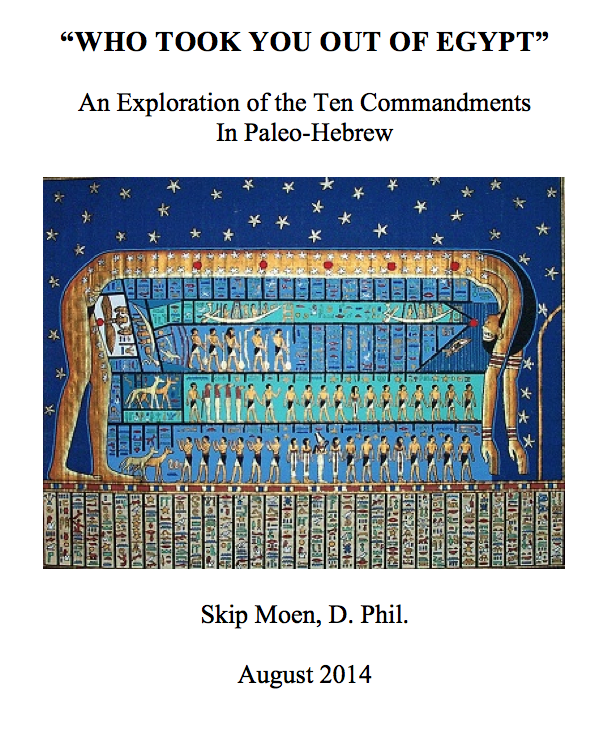THE TEN COMMANDMENTS IN PICTOGRAPHS
Announcing a new study on the pictographs of the Ten Commandments.
Over 100 pages of analysis. Every word in the entire Exodus account of the giving of the commandments. Linguistic and theological comments. Dozens of Paleo-Hebrew images.
Read about the fascinating background of our Hebrew text in its original form. Consider some of the implications of Paleo-Hebrew in this new study of the Ten Commandments from the book of Exodus. CLICK HERE TO ORDER





Hi Skip, I trust all is well on your trip and am keeping you and yours in prayer towards fruitfulness.
Just wanted to drop you a note on the paleo hebrew that you made available to us. I just purchased it and I wanted to share an insight I gleaned concerning patterns or flow, as opposed to “translation” proper. Please bear with me as I’m unable to figure out how to copy and paste the paleo font and send it. (I even tried writing it on my screen with a magic marker and sending it. Didn’t work!! :)
Anyhoo….. I liked the part concerning the connection to the reversal of lo towards el (not verses? strength), and as I was learning and sharing the concept behind the “letter” tet, I came across a similar situation that I am now intending to pursue more often.
As you no doubt know, it’s not represented anywhere in scripture as a “word” or concept which makes it a bit harder to determine the origin and/or meaning behind it. (hence the oft quoted notation, “unknown origin”, I have an inkling that because of its placement in the series of letters, it quite intentional) In short, the closest I’ve been able to come to it (biblically) is tet-yod-tav which is associated with stickiness. However, when written out in paleo, it shows an interesting pattern. (just in the “seeing” of the letters) tet (a full basket or containment (total) – yod (working hand/putting your “hand” to it )- and tav (the mark or end destination). Because the tet is a tav-contained or surrounded, it could be seen as, “containment whose purpose is to un-contain (set free). In other words, taking off the restraints, full blessing as was originally intended. Anyway, there’s a lot more there, and I’m probably sharing this prematurely, as I’ve only just started reading the document, but I thought I would share anyway, as this arena of study is close to my heart.
I hope all is well with you and I trust God is using your efforts to build His kingdom on earth. What a mind blowing concept, that we as mere men could have a hand in what is truly only His work. IN HIM, I live and breathe and have my being.
YHWH bless you and keep you………
Another thought.
From page 79 concerning the term Shabbat.
“Seekins explanation depends on the “key word” concept. Given what we learned about
the “six day” covenant, perhaps the pictograph does mean “return to covenant,” but that
would assume that the first audience previously practiced a seventh day of rest or at least
recognized the religious significance of the seventh day. However, if that were true,
there would hardly be any need for the expended explanation of the application of
shabbat to household members, strangers and even animals.”
Perhaps there’s something a bit larger going on here, if we leave behind the idea that a “previous” day of rest was either practiced or not and read it as suggested by Seekins, could it be possible that the “returning to covenant” would suggest to these ex-slaves the commitment God initiated with Abraham.
Just to attempt to clarify the thought, the “covenant” with Abraham was a “first” (maybe only?) of it’s kind in the sense that it pertained to Abraham and his prodigy specifically insofar as that he would be a blessing to the nations and that the restoration would occur through his seed.
I’ve heard many thoughts on whether the Sabbath day had been practiced before the exodus or not and I’m not sure whether it’s even a legitimate question or not considering that the origin of order (Genesis) wasn’t given until after the exodus. (note: that wouldn’t mean that either the Genesis account or the Sabbath day wasn’t know or practiced previously, only that this is the “order’ or pattern that it was given to the Hebrews and therefore us.)
To encapsulate a bit, perhaps the story of creation leading up to the account of Abraham was given to the people in order to establish the “sign” of the covenant (the Sabbath) with those who would choose to follow YHWH as Abraham did, and the returning (weekly) was a reiteration of both their part (Abraham’s seed) and God’s part (the restoration and blessing through him) of that same covenant.
As a side note; I’m not implying that the “sole” intent of the creation account was to “only” establish the Sabbath day, I’m pretty convinced that it covers a whole lot more territory that we could possibly imagine. Much like a color stripe in a rainbow, it’s only one aspect alongside and combined with many others.
“and the two shall become one”……
YHWH bless you and keep you………..